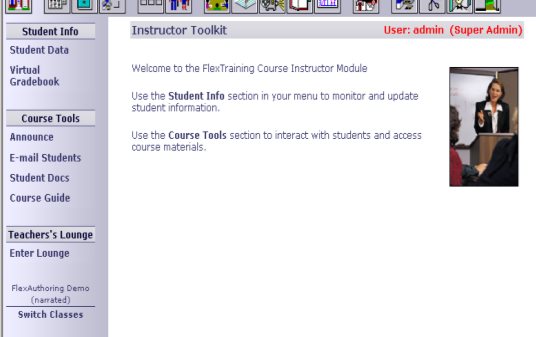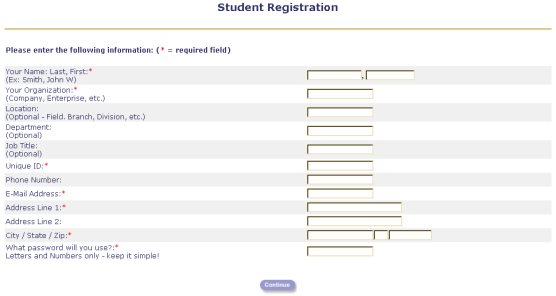
FlexTraining Management Guide
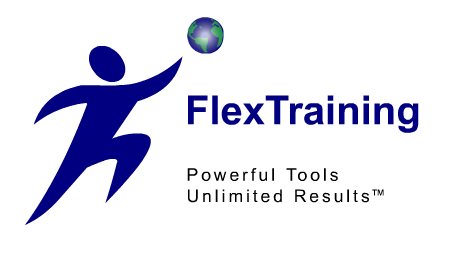
The FlexTraining Total e-Learning Solution
Management Guide
Version 5.2
Copyright 1998 - 2006 Online Development
Instructor Menu
A Course may be defined by the Administrator as requiring an instructor or defined as not requiring one. When an instructor is used, he or she interacts with the students and course content by using the Instructor Menu.
Installations where there are no courses that require an Instructor need not use the Instructor Menu at all.
The Instructor Toolkit consists of three sections: Student Info, Course Tools and the Teacher’s Lounge. These sections can be used by the Instructor to keep track of students and their progress and to communicate with students.
Non-Instructor Users may use the Instructor menu as well. They will have the option of selecting a class to view from a list of all classes, whereas an instructor will be forced to select from a list of classes that are assigned to them.
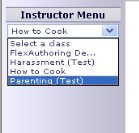
Once you have chosen a class, you will see the three groups of options and an option to select a different class to work with.
Student Info
Student Data
The Student Data section lets you view student information including demographic information about each student in your class. Information listed includes:
- Student Number
- Student Name
- Organization
- Phone Number
- Physical Address
- E-mail Address
Each email address is a hyperlink. You may click on an address to send an email message to that student.
Virtual Gradebook
This feature provides a display screen that lets you see, at a glance, which sections and tests each student has completed. This is also where you may add/change a grade for all completed Assignments.

Simply check the box beside a Section or enter a score for a test or assignment to indicate that it was successfully completed. If an assignment or test was completed by a student, you may place the student’s grade within the corresponding assignment’s input box. Grades may be numerical or alphabetical (i.e., 100, 80, A, B, 0 & F). ( F’s and grades lower than 60 represent failing grades.)
When you are finished checking off assignments (or un-checking them), click the Update button.
The system tracks the completion of online Tests and automatically tracks which course sections a student has read. However, it is up to you, as the instructor, to determine that a student has completed an assignment and to update his progress accordingly using this screen.
Accordingly, courses that have no Instructor should not have class assignments.
Course Tools
Announce
This feature allows Instructors to post announcements for any authored lesson.
Message Board
The Message Board is a forum where students post answers and comments to discussion questions issued. An Instructor may access the Message Board to pose a question, and then the students would access it to respond and submit answers.
Also, you might access the Message Board to periodically review the level of participation of each student, and the quality of their ongoing discussions. It is a good way to assess how the students are picking up the material and what kinds of prior knowledge the students bring to the course.
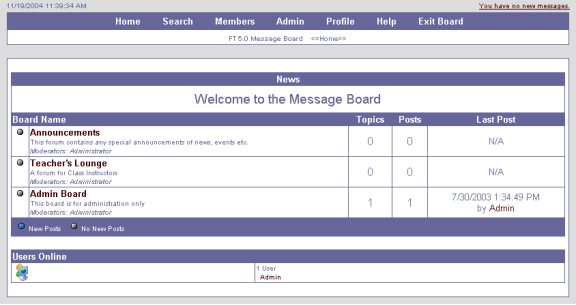
Chat Room
The Chat Room allows the user to "chat" with another user who is online in “real time” and/or send a URL address. The user can chat with an Administrator, another student and/or an Instructor, all within the same window.
Note: The Message Board and Chat Room do not come standard with the FlexTraining software. You must purchase a valid licensing agreement in order to access these facilities.
Email Students
This menu option allows you to send an email to the entire class or to individual students without remembering or typing any email addresses. Just check all student names or check only the individuals you wish to send an email to, and then click on the “Compose Message” button and your email window will appear.
Type a Subject and your message and send the message as usual.
Course Docs
Add new documents to or remove documents from the Document Exchange. Also, search for a specific document or look for certain attributes.
Online Course Guide
This option opens up the Online Course Guide Viewer in the right frame of the screen. The Course Guide Viewer consists of a top and bottom section.
Top Section: Course Guide Navigator. Lets you choose which Course Guide section you want to view. Click on a Course Guide section title to see that section. The Navigator stays visible while you move from section to section.
Bottom Section: Course Guide Content. Displays the section you clicked on in the Course Guide Navigator above.
Teacher’s Lounge
Enter Teacher’s Message Board
This Message Board has the same functionality as the “Student Side” Message Board, only this is specifically set up for “Instructor access only.“
If Message Board is not defined for your class, this option will not appear on your Instructor menu.
Advanced Menu
Advanced Options
Choose whether or not users can save their password when entering the Management Center.
Languages
Multi-Language Support
Select multi-language support, if desired.
Define a Language
Choose an existing, “default” language that will be used in the Student Module.
Display Icons or Text
Choose to display flag icons or text in the Student Module language selector. Next, choose a language to edit the icons.
Select a Language
Select an existing language or enter a new language.
Add/Edit Language Text
For a new language, translate the English values to the selected language values as they will be viewed in the Student Module and “Save.”
Document Libraries
FlexTraining includes a user-definable set of Virtual Document Libraries. Each Library may contain as many documents as you wish, organized into various “Document Types.”
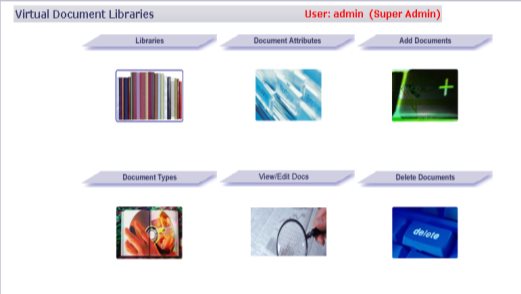
Libraries
As the Administrator, you define the name and location of each library. You will need to build a “Student” Library, and you may build one Library per Course, as well. The Student library will only be viewable from the Management Center module (and should contain information about the Students, not Course-related material), while the “Course Libraries” may be accessed and searched by any student who has signed on to that particular Course.
Document Types
Within each Library, you will define one or more Document Types. Document Types should reflect the nature of the document and its content, NOT the file format. For example, “Job Application” and “Memorandum” might be good Document Types while “Excel” and “Acrobat” would be better defined as “Document Attributes” (see below).
Document Attributes
Each document type within each library needs to have one or more attributes defined. Attributes are like data fields, with values for each document that help you identify the document. For example, an Attribute for a “Performance Evaluation” Document type might be “Employee Number,” and values might be “12345” and “45678.” Another attribute for a “Performance Evaluation” could be “Date,” with values representing the date the evaluation was conducted.
Remember that all Document Types and Attributes are defined by you, the Administrator.
Any attribute you define MUST have a column of the same name in the Documents table. The Documents table comes with many columns that make excellent Document Attributes, such as “Subject,” “Title” and “Keywords.” If you define an Attribute that is not a column in the Documents table, you will need to add that column to the Documents table.
The libraries are defined using the FlexTraining Management Center module. Library, Document and Attribute Information, as well as the names and locations for all the documents you have stored, are kept in the FlexTraining database.
View/Edit Docs
This screen is used to search for a document for editing purposes. Choose a library from Documents, Main or Student, and any other libraries you may have created yourself. From this selection, drill down to find your document as noted in the following sections: (Tip: every document belongs to a document type and has search attributes.)
Choose a Library. The system will now show a list of document types that belong to that library. In the Documents pull-down list, select a document type. Enter any search filters. Choose an attribute to sort the results by and click on “Search.”
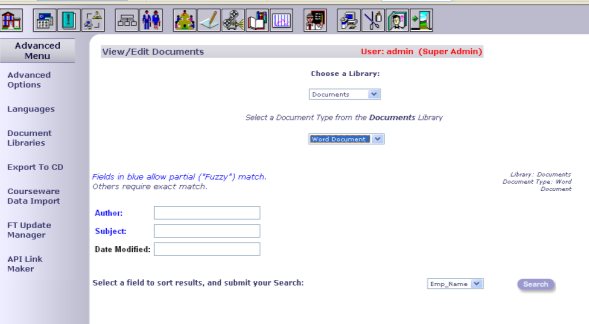
When you see the results list of documents that match your search criteria, find the document you want to edit and click the pencil to edit the attributes.
Add Documents
Upload documents to a new or established Library and then select Attributes. Choose a Library, choose a Document Type, browse and upload the document and enter any optional Attributes.
Delete Documents
Just as you can add to the document library, you have the option to delete documents.
Export to CD
The Export to CD function allows you to export a single course onto CD. This is a valuable tool for training students that do not have an Internet connection or do not require information tracking.
Not all courses can be exported to CD. The course must contain no external links and must be a FlexAuthored course.
You must also have a CD writer and CD writing software installed on your server in order to take advantage of this feature. The Export to CD function creates the file tree but does not physically write to the CD for you. That is left up to the administrator of the server.
Courseware Data Import
The Courseware Data Import facility makes it possible for you to use external learning systems and testing tools, and yet keep your students' data consolidated within the FlexTraining centralized database. It brings your data, converted to a usable format, into FlexTraining for integration with your main repository of registration and course activity.
FT Update Manager
This is a utility that is run after a bug patch file is unzipped into the system that does any database alterations necessary and updates the database to reflect versioning/dating.
API Link Maker
The API Link Maker function creates URLs that can be sent to students to enable a quick login. This can be valuable for demonstrating FlexTraining to potential students.
You can create an API link based on an email address, student number, unique id, student name, password or any combination of these items.
Utilities Menu
The Utilities section makes it easy for you to manage deletion of classes, courses, students and time logs. You can also view a list of images included in the Authoring Tool or FlexAuthoring (see image below).
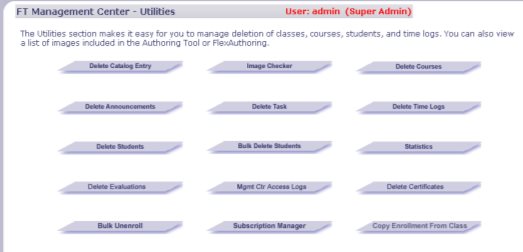
Concept: Course Structure and Content
Before using FlexTraining to define all the elements of your course, give some thought to what you want to teach and how you want to present your course to your students.
Questions you should answer include:
Should this class have an Instructor, to provide guidance and expertise, and to issue and accept assignments?
Should you issue assignments for the students to complete which would then be evaluated by the Instructor?
Where will the course material come from, whether it’s material from the built-in authoring tool, existing word-processed documents, newer HTML or text pages or web sites that exist elsewhere on the network?
Should the students have to pass tests, and if so, how many?
In what format should the Course Guide be provided? For example, chapters comprised of HTML sections and/or a single-file word-processed version.
Diagnostics
Use the Diagnostics feature to proactively check system options, ODBC source connections and other various system functions. Diagnostics finds configuration errors before they cause problems.
To test the ODBC connections, simply enter the name of your ODBC source and then click the "Test Connection" button (i.e., FT50). If your connection is not set up correctly or if you accidentally typed the incorrect source name, a description of the error will be displayed along with the source name you entered.
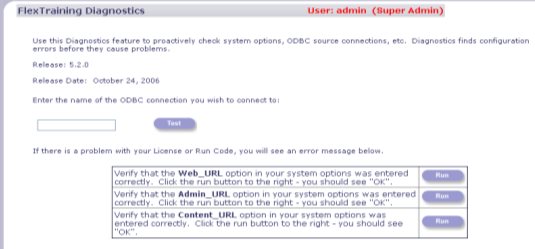
Setup Check
The Setup Check facility provides you with a way to quickly locate setup and configuration errors before they cause on-screen errors and processing interruptions.
Run System Check after you add courses, schedule classes, add students or perform other maintenance activities.
System Check does not actually correct problems. It merely informs you of setup or data problems so you can take action to correct them yourself. A typical System Check run might yield a report like the following example, assuming that the System Administrator in this case had been somewhat careless in setting up FlexTraining course components:
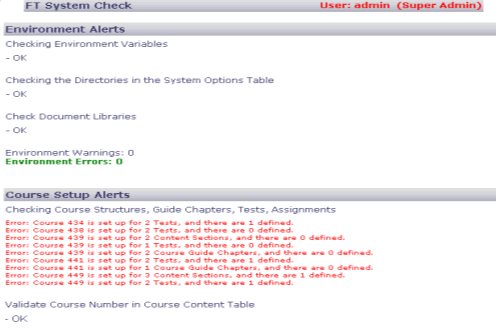
Concept: What content type will be most effective?
Sometimes, text and a few images can be as or more effective than streaming video or multimedia.
In fact, IBM has discovered that because the global nature of its business and its employee base, a still photo accompanied by self-paced text may be the best format. Users can read and scroll through the text at their own pace, re-read sentences that may be unclear or warrant additional attention, or simply stop and reflect, and then return to the presentation — all without losing their place or missing any of what the source is “saying.”
Sometimes, in our eagerness to adopt all the new “bells and whistles” of a new technology, we forget that self-paced text may be the most powerful and preferable learning tool of all.
- from Peter Orton, Ph.D.
IBM Management Development
Delete Catalog Entry
Use this function to delete a scheduled class from the catalog. This will not delete the course structure (tests, sections, assignments or guides). It will just make that class not available to the public.
Delete Courses
Allows the user to delete a course, all corresponding classes and all associated files. Everything is deleted related to this course. You must enter the deletion password to verify that you wish to do this because the process is irreversible.
Delete Students
Using this feature removes a Student from ALL DATABASE TABLES within FlexTraining. It starts in a "Proof" mode, so you will have an opportunity to view a student's basic record before finally deciding to execute the Delete operation.
Bulk Student Delete
This function works like the “Delete Students” feature but allows you to delete several students at once.
Delete Time Logs
Delete Time logs by student, class and/or date. You may also delete all Time Log entries.
Image Checker
The Image Checker allows the user to view a list of all images referenced in the Authoring Tool or FlexAuthoring. The user may utilize this list to remove any images that are using up valuable hard drive space.
Statistics
This section provides system statistics on courses, skills, the authoring tool, students, user, hard drive usage and other miscellaneous statistics.
Management Center Access Log
The Management Center Access log tracks all major events occurring in the FlexTraining Management Center. This includes, but is not limited to, System Configuration changes, user creation and user deletion.
Delete Certificates
This section provides a method of removing unassigned certificates from the system. If a certificate is assigned to a class, it is not removable.
Bulk Un-enroll
This function un-enrolls students from FlexTraining classes in bulk using various filters. This does not delete students from the student table, only classes.
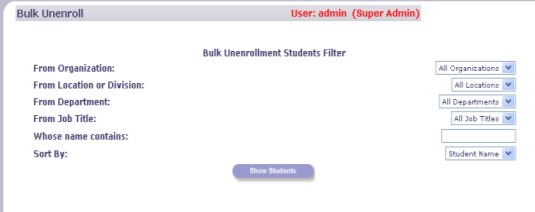
Subscription Manager
Allows the administrator to edit the subscription dates for a student’s enrollment in a class. Determines the length of subscription that will be available.
Copy Enrollments
Copies student enrollments from one FlexTraining class to another.
Operating the Student Module
The Student Module is the location that all students will use to enroll in a class and to subsequently access the Student Menu.
The address of the student module is defined at Installation time (see the Installation section of this guide). It is typically of the form:
https://yourservername/FT or https://www.yourcompany.com/FT
Enrolling in a Class
From the Student Module startup screen click on the “New Students” link.
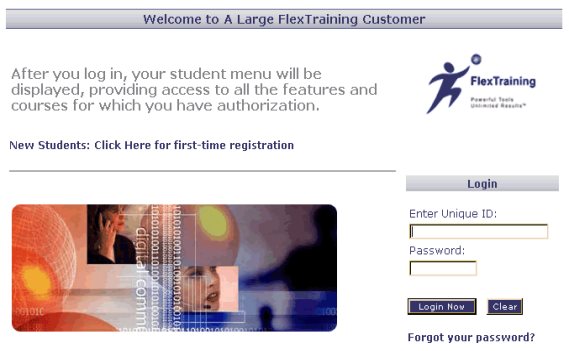
If you have previously registered for a class at this site, you may go ahead and login.
For new students, the signup dialogue will then begin with the following screen:
Using the Student Menu
Students must sign on using their unique ID or email and their own password each time they wish to access their Student Menu.
After a successful sign on, the Student Menu appears (Home page).
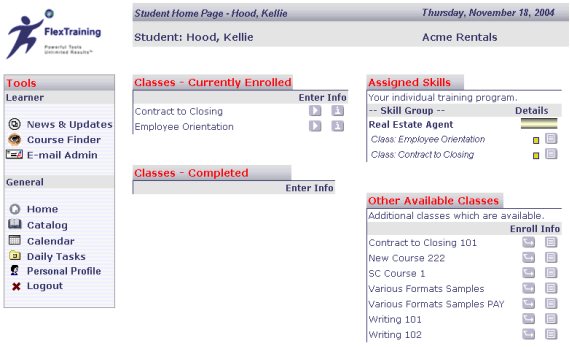
Home
This is the Student Module main or “Home” page. On this page the student can view a “Task” list of all available Sections, Assignments and Tests. Simply click on a link next to the desired task to enter its page. Tests may be available only as defined by the Administrator (i.e., if the Administrator has defined a final to be taken only after the student has read all the course sections and has completed all assignments, then a link to the Final Exam test will be available AFTER all the sections and assignments have been completed).
Home Page Menu
On the homepage you have access to various facilities as listed below:
- News & Updates
- Course Finder
- Email Admin
- Catalog
- Calendar
- Daily Tasks
- Personal Profile
- Logout
Home Page Features
The homepage also lists the following items:
- Classes – currently enrolled
- Classes – completed
- Other Available Classes
Appendix A - 5.1 to 5.2 Changes/Additions
|
Name |
Description |
|
Bulk Un-enroll |
New Bulk Un-enroll function on utilities menu speeds the un-enroll process. |
|
Subscription Manager |
Tool to allow the system manager to edit the subscription dates for a specific student's enrollment in a class. |
|
FlexAuthoring: AT Text blocks |
Changed internal handling of text blocks to prevent rogue “~” character from destroying a learning screen text section. |
|
License Usage Indicator on Admin Home Screen |
Shows how much student capacity is used and encourage upsizing when needed. |
|
FlexAuthoring: Streamlined Define Layout screen |
Tweaked the Learning Screen define screens, avid scrolling, provide quicker defining process. Removed the “delayed audio” option altogether. |
|
Additional Enrollments copying |
Created a process to copy the enrollments from one class to another class. |
|
Enhanced CD Export utility |
CD Export Utility now can handle all FlexAuthoring Learning Screen template types, as well as content that is not authored. |
|
Credits Hours in reporting |
Credit hours now shown and accumulated on both the Enrollment and Tuition reports. |
|
Free-Form Text question for evaluations |
Added a place for comments on each Course Evaluation. |
|
Session Timeout |
Provided a session timeout override so user can keep his session alive for longer durations before automatic logoff. |
|
Customizable Login Page Picture |
Picture changing option for Student Login page makes page more customizable. |
|
FT Update Manager DB Adjuster |
Utility to run after an update file is unzipped that does any database alterations necessary and updates the database to reflect versioning/dating. |
|
Media Library & Course List Filtering |
Improved filtering system for media library and course listings. |
|
Email Target Matrix |
Email matrix defines who gets mail when events occur. |
|
Multi Language Mode |
Allows definition of multiple languages for use on all screens throughout on the student module. Students can have the ability to choose their language from a list. |
|
Promo Codes for e-commerce |
Promotional codes for e-commerce allow a reduced enrollment fee for a class. |
|
Visual Course Builder – Test Builder |
Enhanced the Visual Course Builder to allow the visual revision of test questions and rapid editing of test question sequence. |
|
Disable Enter Key in tests |
Forces the “Enter” button to work as tab button, to avoid accidental submission of tests by a student pressing the Enter key. |
|
Test Back Button Prevention |
Prevents the user from clicking the Back button after failing a test, then changing their answers and resubmitting the test. |
|
Student Add using hierarchy |
Modified the Add Student routine to allow selection of hierarchy PRIOR to choosing what classes to enroll the student in. |
|
Student Module: Visual Student progress tracking |
Left frame on student menu now keeps graphic progress indicators of section and test completions. |
|
FlexAuthoring: Enlarged single text entry or content-paste box |
Learning screens with a single text item – typically a large item – now display a single enlarged text entry box. |
|
FlexAuthoring: Add/remove learner exercises |
You can now add or remove a learner exercise after the initial save. |
|
FlexAuthoring: Copy Screens between courses |
You can now copy screens from one FA course to another course with the click of a button. |
Glossary of Terms
API Link MakerAPI (Application Program Interface). A function that creates URLs and can be sent to students to enable a quick login.
ASPASP (Active Server Pages). A programming environment that combines elements of HTML and scripting.
AssessmentA pre- or post-test designed to measure the effectiveness of training or student readiness for the course.
AssignmentsAn action or task built into a course. Text, images, video, audio or other web pages may be added to the Assignment Directory.
Asynchronous LearningStudents are online at different times. Best suited for self-directed learning model.
Authoring ToolA tool used by instructional designers to create E-Learning courseware.
Catalog WizardAdds and edits classes in the Class Catalog (a/k/a Schedule Wizard).
CertificatesA certificate of completion assigned to a course.
Chat RoomA forum that allows the online user to “chat” with another online user in “real time.”
ClassAn instance of a course, wherein several classes may be built on the same course.
Class CalendarA list of classes available for enrollment and displayed by start date.
Content DirectoryA default directory of course content, including images, video, audio or other web pages.
Content LibraryA collection of uploaded files; also, allows the uploading of new files.
CourseA collection of definitions and material, such as content sections, a course guide, tests and, optionally, assignments.
Course FinderA search tool that allows students to find courses available for enrollment.
Course EvaluationAn evaluation of course to be completed by students.
Course GuideWritten supplemental or technical materials for a course, consisting of one document per file, that are used as a reference and not accessed as part of a course.
Course LibraryCourse-related material that may be accessed and searched by any student who has signed on to a particular course.
Course SequenceThe order or sequence of sections in a course.
Courseware Data
ImportingA function that brings existing data, converted to a usable format, into FlexTraining for integration with course activity. Rarely used.
DBMS(Data Base Management System). Used by an LMS to track course structures and student progress.
DiagnosticsA feature that proactively checks system options, ODBC source connections and other various systems functions.
Document LibrariesA user-defined set of virtual documents. Each library may contain as many documents as desired, organized into document types.
Dynamic MessagesA message that is used in training content, with formats that include a JavaScript “alert” box, a Flash movie, streaming video or a text message.
eCommerceAn electronic form that redirects students to payment processing pages wherein credit card information is processed through a designated clearing house.
Edit StudentFilters that allow you to sort “student data” by organization, location, department or partial student name and edit student information.
Enrollment StatusStudent enrollment status as designated by the Administrator. Students may be “active,” “pending” or “payment” (requiring pre-payment).
Enrollment Subscription
PeriodPeriod of time that is a designated to make course enrollment available to students.
Export to CDA function that enables you to export a single course onto CD for students that either do not have an internet connection or do not require tracking information.
FlashMacromedia software used to create computer animations.
GIF(Graphics Interchange Format). A format used to store images.
HomeThe Student Module main or “home” page, wherein the student can view a task list of all available classes, assignments and tests.
HTML(Hyper Text Markup Language). The programming language used to create documents for display on the World Wide Web.
HTTP(Hyper Text Transfer Protocol). The set of rules and standards that govern how information is transmitted on the World Wide Web.
Import StudentsA feature that imports student data from a spreadsheet.
Instructor-led TrainingStudents interact with a mentor, expert or leader during the course.
Item AnalysisA report containing test questions, available answers, correct answers, number of learners who took the test, percentage of correct answers given and an answer-by-answer breakdown.
Item BankingUsed in assessments to randomly select test questions from an established pool of questions.
JPEG(Joint Photographic Experts Group). A format for image compression to weigh image quality against file size.
Learners MenuManages student information and all their associated data, including class progress, student information, password and more. Allows you to add, edit or delete student records.
LMS(Learning Management System). A framework for creating and managing online courses and student enrollments.
Management CenterThe Management Center Access Log tracks all major events occurring in this center including system configuration changes, user creation and user deletion.
Media LibraryA collection of “dynamic messages” to be used in training content.
Message BoardA forum wherein students post answers and comments to discussion questions issued.
MultimediaEncompasses interactive text, images, sound and color.
ODBC Source(Open Database Connectivity). An application program interface to access information from numerous types of databases.
Open Source CodeThe source code for software that makes it available so that users can access, modify and redistribute it.
PayPal AccountStudent PayPal account that facilitates student payment for classes.
PDF(Portable Document Format). File format allowing users to view documents exactly as they were created.
Progress TrackingProvides a list of all profile records with the current progress for each student/skill group combination.
RolesFunctions and access levels designated by “Administrator” that impact all roles established within the training environment.
ScalabilityThe degree to which a computer application or component can be expanded in size, volume or number of users served and continue to function properly.
Schedule WizardAdds and edits classes in the Class Catalog (a/k/a Catalog Wizard).
SCORM LogA report containing results from any SCORM-compliant course sections. (Sharable Content Object Reference Model specifications).
Session ObjectSession that is created and maintained for each FlexTraining user and remembers who they are, what they are doing and the name of the database they are working with.
Setup CheckFunction that provides a way to quickly locate setup and configuration errors before they cause on-screen errors and processing interruptions.
Skill GroupsAllows you to add, edit or delete up to 10 pre-requisite and competency records for a course.
Skills MenuIdentifies student-specific training requirements for a given online learner.
SME(Subject Matter Expert). Uses knowledge of topic to create courses or serve as a course instructor.
Source CodeProgram instructions written by a software developer and later translated into machine language that a computer can understand.
SQLA language for accessing information in a database and updating entries.
StatisticsProvides system statistics on courses, skills, the authoring tool, students, users, hard drive usage and other miscellaneous statistics.
Streaming MultimediaAudio or video that plays while it is being loaded, providing a faster and better learning experience.
Student LibraryA user-defined library viewable only from the Management Center module containing information about students (not course-related material).
Student ModuleThe location that all students will use to enroll in a class and subsequently access the Student Menu.
Student NotebookA tool that the student can use to jot down ideas or other notes while viewing a course. The notebook can be downloaded for study purposes and can be used during an open book test.
Student-led trainingAutomated, self-paced, private learning model, also called “self-directed learning.”
Synchronous LearningA real-time learning event in which all students are online at the same time and communicate directly with each other. May use chat or other interaction tools.
Table MethodCourse building methodology that provides a matrix view of the flow of course events. Can be used to create, augment and edit a course. Used to assemble the actual “pieces” that make up the course.
TemplateA predefined set of tools that establish the structure and settings necessary to quickly create content.
Time Limited EnrollmentsA function that specifies the period of time students have to enroll in a course.
Time LoggingA report of the time it took a student to complete a test.
Training EffectivenessA report comparing the learner’s pre-test and post-test scores per student, per course.
UploadTo send a file from one computer or server to another.
URI(Uniform Resource Identifier). Name and address of information – text, graphics, audio, video, etc. – on the Internet. A URL is the most commonly used type of URI.
URL(Uniform Resource Locator). The address of a page on the World Wide Web.
Users MenuIndividuals that are authorized to access the administrator materials and assigned specific roles and access levels.
Utilities MenuSection to manage deletion of classes, courses, students and time logs.
Vector GraphicAn image created based on mathematical formulas rather than by an array of dots.
Virtual DirectoryA specific directory for the FlexTraining Application Directories.
Virtual GradebookThe main repository for tracking training programs, including online and classroom courses. Allows manual entry of test or assignment results for any student in a given class outside of FlexTraining.
Visual MethodCourse building methodology that provides a more graphical view of the flow of course events. Can be used to create, augment and edit a course.
Waiting ListStudents that are waiting to enroll in a course if the class’s maximum enrollment has been reached.
XML(Extensible Markup Language). Webpage coding language that allows site designers to program their own markup commands, which can then be used as if they were standard HTML commands.
